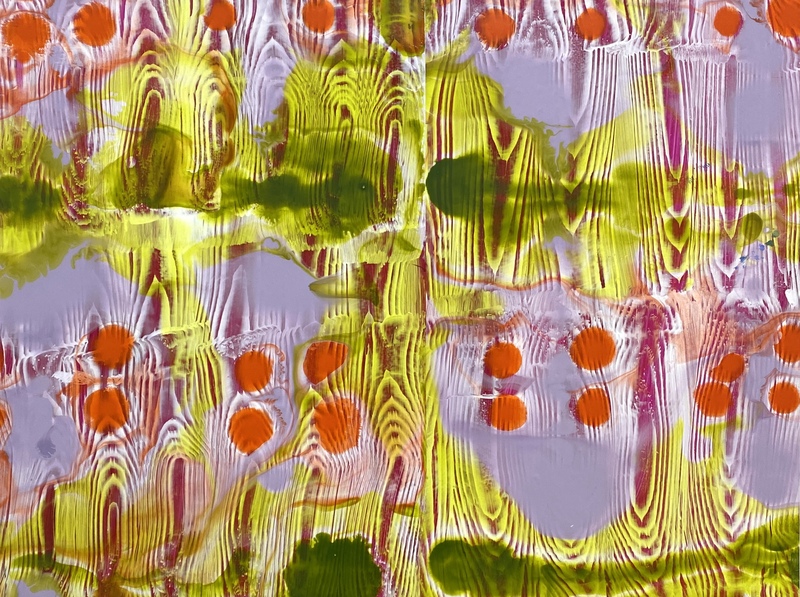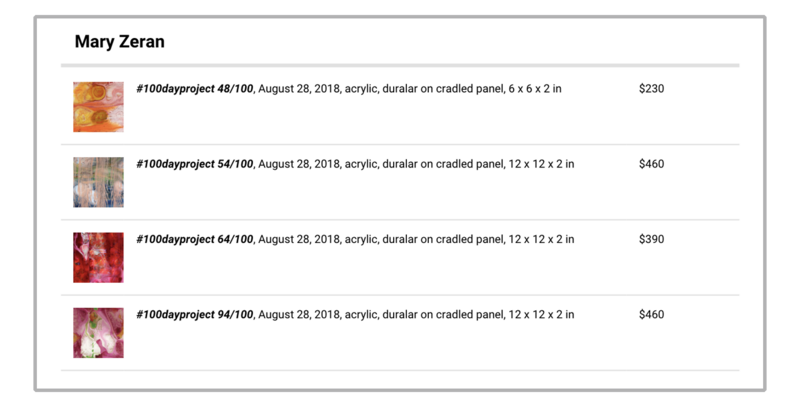Photo credit: Mary Zeran
Discover how third-generation artist Mary Zeran transformed her art business using Artwork Archive's Reports Feature.
Artist Mary Zeran grew up in a family of women artists where textiles, embroidery, and woodcarving were their visual language. Mary paints contemporary abstract paintings on archival polyester film with acrylic paints, delving into a vibrant world where colors merge to evoke emotions.
As Mary interprets and abstracts nature, "she speaks her mother tongue," explaining that this language brings her closer to her family’s traditions, histories, and stories.
She relies on Artwork Archive for various aspects of her practice—using the platform to manage her inventory, track pieces in her studio and those on display in galleries, create tear sheets for collectors, and generate labels for mailing purposes seamlessly.
By leveraging Artwork Archive's features, Mary Zeran has found a powerful solution to the challenges of staying organized as her art practice grows and evolves. Here’s what she had to say:
Making the Move from Spreadsheets to Artwork Archive
Before integrating Artwork Archive into my workflow, I relied on an Excel spreadsheet to manage my inventory.
However, this method proved cumbersome and inefficient. Tasks like creating invoices, tracking sales, and generating Report PDFs were all done with Microsoft Word. That method was time-consuming and created a lot of retyping of the same document.
Now, I can access comprehensive details about each piece effortlessly.
No more endless scrolling through rows of data—I can quickly locate any artwork I need. Plus, I can easily track pricing, sales history, and assess the performance of galleries in terms of sales.
With Artwork Archive, everything is centralized, significantly streamlining my operations.
An example of a Portfolio Page from artist Mary Zeran of her work Shibori #12
Artwork Archive Tip:
If you're tired of struggling with spreadsheets like Mary Zeran was, try out Artwork Archive for yourself. You can sign up for a free 14-day trial here.
Streamlining Address Labels and Contact Management with Artwork Archive Reports
Initially, I began utilizing Artwork Archive's reporting feature to streamline the creation of address labels.
Previously, I'd been typing each one into an Avery document—it was a nightmare.
With the old manual system, I couldn't separate the names and addresses into categories, and changing information was so labor-intensive. After I started using the address label feature on Artwork Archive, I was able to make changes easily. I enjoy the ability to categorize my contacts by collector, curator, and arts organization within the system.
Artwork Archive Reports Solve the Difficulties of Art Inventory
The inventory features within Artwork Archive have been indispensable, especially while I was organizing pieces for a retrospective at a local museum.
Before, I would have created a document in Microsoft Word, complete with images and descriptions. This process was prone to inaccuracies and time-consuming. Artwork Archive allowed me to review past works, check availability, and curate pieces for the exhibition. Plus, having access to collectors' addresses made borrowing pieces seamless.
Recently, I was asked to submit several pieces for a corporate proposal that had a tight deadline, and I was pressed for time. Thankfully, creating a Tear Sheet for those works within Artwork Archive enabled me to provide the necessary information to the gallery in record time. As a result, I sold 24 pieces to a hospital in Massachusetts!
Shibori #19, Mary Zeran. Acrylic, Dura-Lar on cradled panel, 30 x 40 x 2 in (76.2 x 101.6 x 5.08 cm)
Integrating Artwork Archive into Weekly Workflows for Maximum Efficiency
One standout feature for me is the ability to effortlessly generate PDF Reports specifically tailored for galleries and art consultants.
I also rely on Artwork Archive weekly to streamline various tasks such as address labels, invoices, and exhibition reports.
Specifically, the Consignment Report had become invaluable each time I restocked a gallery with new artwork. I also use it for an end-of-year inventory process. It's a crucial tool for tracking which pieces are currently held by galleries.
The Reports Feature has reduced the time I spend on administrative tasks for my art business and allows me to spend more time painting.
Leveraging Artwork Archive Reports for Insights into Your Art Business
The Sales Report provides valuable insights into my top collectors, enabling me to ensure they're informed about new series releases.
It also helps me strategize my marketing efforts more effectively. The Tear Sheet is a regularly used tool in my studio workflow.
I typically title my pieces while entering them into Artwork Archive. When I'm finished, I generate a Tear Sheet of the new works and bring it back to the studio.This provides me with a convenient reference sheet when writing titles on the back of paintings. Moreover, it's incredibly user-friendly when clients want information about a piece for potential purchase.
An example of Mary Zeran's tear sheet and price list created in Artwork Archive.
Artwork Archive Reports Enhance the Grant and Exhibition Application Process
The ability to create PDF Reports is among my favorite features within Artwork Archive.
I've used Reports extensively to apply to museum shows. Customizing the form empowers me to tailor its contents to my needs precisely. This includes incorporating my logo and adjusting the included information based on the specific requirements of each situation. I always feel like my applications look professional and well-presented.
My galleries love the Consignment Reports. Being able to include the photograph in the reports makes it easy for them to match the title and details to each piece. Plus, they love how easy the reports are to read. They especially like that all the necessary information is consolidated into one convenient document.
Artwork Archive Tip for Customizing Reports:
-
Create templates: Artwork Archive offers a variety of report templates, such as inventory reports, gallery labels, and consignment reports. You can select the amount of information and data to include on each report and then save these presets in your account.
-
Include your branding: Incorporate your logo, headshot or a branded header into the report to maintain a consistent and professional look across all your documents. See how to upload a header here.
-
View and edit: Once you have generated your report, you can find it in your Reports tab. You can then also click on the quick edit icon to make changes to your report.
Are you ready to take your art business to the next level?
With Artwork Archive's powerful reporting features, you can streamline your grant and exhibition application process, create professional-looking documents, and impress galleries with ease. Simplify your art business management and focus on what matters most – your creativity.
Sign up for a free 14-day trial of Artwork Archive today and experience the difference for yourself.











